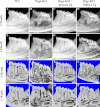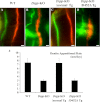Proteolytic processing of dentin sialophosphoprotein (DSPP) is essential to dentinogenesis
- PMID: 22798071
- PMCID: PMC3436292
- DOI: 10.1074/jbc.M112.388587
Proteolytic processing of dentin sialophosphoprotein (DSPP) is essential to dentinogenesis
Abstract
DSPP, which plays a crucial role in dentin formation, is processed into the NH(2)-terminal and COOH-terminal fragments. We believe that the proteolytic processing of DSPP is an essential activation step for its biological function in biomineralization. We tested this hypothesis by analyzing transgenic mice expressing the mutant D452A-DSPP in the Dspp-knock-out (Dspp-KO) background (referred to as "Dspp-KO/D452A-Tg" mice). We employed multipronged approaches to characterize the dentin of the Dspp-KO/D452A-Tg mice, in comparison with Dspp-KO mice and mice expressing the normal DSPP transgene in the Dspp-KO background (named Dspp-KO/normal-Tg mice). Our analyses showed that 90% of the D452A-DSPP in the dentin of Dspp-KO/D452A-Tg mice was not cleaved, indicating that D452A substitution effectively blocked the proteolytic processing of DSPP in vivo. While the expression of the normal DSPP fully rescued the dentin defects of the Dspp-KO mice, expressing the D452A-DSPP failed to do so. These results indicate that the proteolytic processing of DSPP is an activation step essential to its biological function in dentinogenesis.
Figures








Similar articles
-
The rescue of dentin matrix protein 1 (DMP1)-deficient tooth defects by the transgenic expression of dentin sialophosphoprotein (DSPP) indicates that DSPP is a downstream effector molecule of DMP1 in dentinogenesis.J Biol Chem. 2013 Mar 8;288(10):7204-14. doi: 10.1074/jbc.M112.445775. Epub 2013 Jan 24. J Biol Chem. 2013. PMID: 23349460 Free PMC article.
-
Failure to process dentin sialophosphoprotein into fragments leads to periodontal defects in mice.Eur J Oral Sci. 2013 Dec;121(6):545-50. doi: 10.1111/eos.12088. Epub 2013 Sep 25. Eur J Oral Sci. 2013. PMID: 24112131 Free PMC article.
-
Role of the NH2 -terminal fragment of dentin sialophosphoprotein in dentinogenesis.Eur J Oral Sci. 2013 Apr;121(2):76-85. doi: 10.1111/eos.12020. Epub 2013 Feb 7. Eur J Oral Sci. 2013. PMID: 23489896 Free PMC article.
-
Post-translational modifications of sibling proteins and their roles in osteogenesis and dentinogenesis.Crit Rev Oral Biol Med. 2004 Jun 4;15(3):126-36. doi: 10.1177/154411130401500302. Crit Rev Oral Biol Med. 2004. PMID: 15187031 Review.
-
Dentin sialophosphoprotein in biomineralization.Connect Tissue Res. 2010 Oct;51(5):404-17. doi: 10.3109/03008200903329789. Connect Tissue Res. 2010. PMID: 20367116 Free PMC article. Review.
Cited by
-
Enamel Defects Associated With Dentin Sialophosphoprotein Mutation in Mice.Front Physiol. 2021 Sep 24;12:724098. doi: 10.3389/fphys.2021.724098. eCollection 2021. Front Physiol. 2021. PMID: 34630144 Free PMC article.
-
The rescue of dentin matrix protein 1 (DMP1)-deficient tooth defects by the transgenic expression of dentin sialophosphoprotein (DSPP) indicates that DSPP is a downstream effector molecule of DMP1 in dentinogenesis.J Biol Chem. 2013 Mar 8;288(10):7204-14. doi: 10.1074/jbc.M112.445775. Epub 2013 Jan 24. J Biol Chem. 2013. PMID: 23349460 Free PMC article.
-
DSPP dosage affects tooth development and dentin mineralization.PLoS One. 2021 May 26;16(5):e0250429. doi: 10.1371/journal.pone.0250429. eCollection 2021. PLoS One. 2021. PMID: 34038418 Free PMC article.
-
Retinoic Acid Signal Negatively Regulates Osteo/Odontogenic Differentiation of Dental Pulp Stem Cells.Stem Cells Int. 2020 Jun 27;2020:5891783. doi: 10.1155/2020/5891783. eCollection 2020. Stem Cells Int. 2020. PMID: 32676119 Free PMC article.
-
Failure to process dentin sialophosphoprotein into fragments leads to periodontal defects in mice.Eur J Oral Sci. 2013 Dec;121(6):545-50. doi: 10.1111/eos.12088. Epub 2013 Sep 25. Eur J Oral Sci. 2013. PMID: 24112131 Free PMC article.
References
-
- MacDougall M., Simmons D., Luan X., Nydegger J., Feng J., Gu T. T. (1997) Dentin phosphoprotein and dentin sialoprotein are cleavage products expressed from a single transcript coded by a gene on human chromosome 4. Dentin phosphoprotein DNA sequence determination. J. Biol. Chem. 272, 835–842 - PubMed
-
- Butler W. T., Bhown M., Dimuzio M. T., Linde A. (1981) Nonocollagenous proteins of dentin. Isolation and partial characterization of rat dentin proteins and proteoglycans using a three-step preparative method. Coll. Relat. Res. 1, 187–199 - PubMed
-
- Veis A., Perry A. (1967) The phosphoprotein of the dentin matrix. Biochemistry 6, 2409–2416 - PubMed
-
- Xiao S., Yu C., Chou X., Yuan W., Wang Y., Bu L., Fu G., Qian M., Yang J., Shi Y., Hu L., Han B., Wang Z., Huang W., Liu J., Chen Z., Zhao G., Kong X. (2001) Dentinogenesis imperfecta 1 with or without progressive hearing loss is associated with distinct mutations in DSPP. Nat. Genet. 27, 201–204 - PubMed
-
- Zhang X., Zhao J., Li C., Gao S., Qiu C., Liu P., Wu G., Qiang B., Lo W. H., Shen Y. (2001) DSPP mutation in dentinogenesis imperfecta Shields type II. Nat. Genet. 27, 151–152 - PubMed
Publication types
MeSH terms
Substances
Grants and funding
LinkOut - more resources
Full Text Sources
Other Literature Sources
Molecular Biology Databases
Research Materials
Miscellaneous

